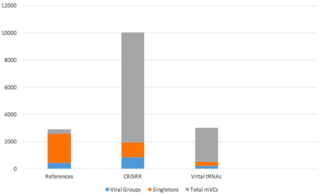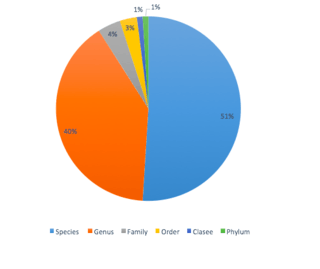Virome
Virome refers to the collection of nucleic acids, both RNA and DNA, that make up the viral community associated with a particular ecosystem or holobiont. The word is derived from virus and genome and first used by Forest Rohwer and colleagues to describe viral shotgun metagenomes.[1] All macro-organisms have viromes that include bacteriophage and viruses, including humans. Viromes are important in the nutrient and energy cycling,[2] development of immunity,[3] and a major source of genes through lysogenic conversion.[4]
In order to study the virome, virus-like particles are separated from cellular components, usually using a combination of filtration, density centrifugation, and enzymatic treatments to get rid of free nucleic acids.[5] The nucleic acids are then sequenced and analyzed using metagenomic methods.
Connections of host virus:
Viruses are the most abundant biological entities on Earth , but challenge in detecting , isolating, and classifying unknown viruses have prevented exhaustive surveys of the global virome.[6] Over 5 Tb of metagenomic sequence data were analysed from 3,042 geographically diverse samples to assess the global distribution, phylogenetic diversity, and host specificity of viruses .[6] Over 125,000 partial DNA viral genomes, including the largest phage yet identified, and increased the number of known viral genes by 16-fold were discovered.[6] A suite of computational methods was used to identify putative host virus connections.[6] The isolate viral host information was projected onto a group, resulting in host assignments for 2.4% of viral groups (Fig 1).[6] Then the CRISPR–Cas prokaryotic immune system which holds a ‘library’ of genome fragments from phages (proto-spacers) that have previously infected the host.[6] Spacers from isolate microbial genomes with matches to metagenomic viral contigs (mVCs) were identified for 4.4% of the viral groups and 1.7% of singletons .[6]The hypothesis was explored that viral transfer RNA (tRNA) genes originate from their host.[6] Viral tRNAs identified in 7.6% of the mVCs were matched to isolate genomes from a single species or genus.[6]The specificity of tRNA-based host viral assignment was confirmed by CRISPR–Cas spacer matches showing a 94% agreement at the genus level.These approaches identified 9,992 putative host–virus associations enabling host assignment to 7.7% of mVCs .[6] The majority of these connections were previously unknown, and include hosts from 16 prokaryotic phyla for which no viruses have previously been identified (Fig 2).[6]It is assumed that most viruses specialize in infecting related hosts.[6] However, this may be an artifact and viral generalists that infect hosts across taxonomic orders do exist.[6] Most CRISPR spacer matches were from viral sequences to hosts within one species or genus .[6]As viruses exploit the host transcription/translation machinery, the existence of viruses with a surprisingly broad range of hosts opens opportunities for identification of novel enzymes or regulatory sequences, with biotechnological applications .[6]
History
Viromes were the first examples of shotgun community sequence,[7] which is now known as metagenomics. In the 2000s, the Rohwer lab sequenced viromes from seawater,[7][8] marine sediments,[9] adult human stool,[10] infant human stool,[11] soil,[12] and blood.[13] This group also performed the first RNA virome with collaborators from the Genomic Institute of Singapore.[14] From these early works, it was concluded that most of the genomic diversity is contained in the global virome and that most of this diversity remains uncharacterized.[15] This view was supported by individual genomic sequencing project, particularly the mycobacterium phage.[16]
References
- ↑ McDaniel, L; Breitbart, M; Mobberley, J; Long, A; Haynes, M; Rohwer, F; Paul, JH (23 September 2008). "Metagenomic analysis of lysogeny in Tampa Bay: implications for prophage gene expression.". PLOS ONE. 3 (9): e3263. doi:10.1371/journal.pone.0003263. PMC 2533394
 . PMID 18810270.
. PMID 18810270. - ↑ Wegley, L; Edwards, R; Rodriguez-Brito, B; Liu, H; Rohwer, F (November 2007). "Metagenomic analysis of the microbial community associated with the coral Porites astreoides.". Environmental Microbiology. 9 (11): 2707–19. doi:10.1111/j.1462-2920.2007.01383.x. PMID 17922755.
- ↑ Barr, JJ; Auro, R; Furlan, M; Whiteson, KL; Erb, ML; Pogliano, J; Stotland, A; Wolkowicz, R; Cutting, AS; Doran, KS; Salamon, P; Youle, M; Rohwer, F (25 June 2013). "Bacteriophage adhering to mucus provide a non-host-derived immunity.". Proceedings of the National Academy of Sciences of the United States of America. 110 (26): 10771–6. doi:10.1073/pnas.1305923110. PMC 3696810
 . PMID 23690590.
. PMID 23690590. - ↑ Sharon, I; Battchikova, N; Aro, EM; Giglione, C; Meinnel, T; Glaser, F; Pinter, RY; Breitbart, M; Rohwer, F; Béjà, O (July 2011). "Comparative metagenomics of microbial traits within oceanic viral communities.". The ISME journal. 5 (7): 1178–90. doi:10.1038/ismej.2011.2. PMC 3146289
 . PMID 21307954.
. PMID 21307954. - ↑ Thurber, RV; Haynes, M; Breitbart, M; Wegley, L; Rohwer, F (2009). "Laboratory procedures to generate viral metagenomes.". Nature protocols. 4 (4): 470–83. doi:10.1038/nprot.2009.10. PMID 19300441.
- 1 2 3 4 5 6 7 8 9 10 11 12 13 14 15 Paez-Espino, David; Eloe-Fadrosh, Emiley A.; Pavlopoulos, Georgios A.; Thomas, Alex D.; Huntemann, Marcel; Mikhailova, Natalia; Rubin, Edward; Ivanova, Natalia N.; Kyrpides, Nikos C. (2016-08-25). "Uncovering Earth's virome". Nature. 536 (7617): 425–430. doi:10.1038/nature19094. ISSN 0028-0836.
- 1 2 Breitbart, M; Salamon, P; Andresen, B; Mahaffy, JM; Segall, AM; Mead, D; Azam, F; Rohwer, F (29 October 2002). "Genomic analysis of uncultured marine viral communities.". Proceedings of the National Academy of Sciences of the United States of America. 99 (22): 14250–5. doi:10.1073/pnas.202488399. PMC 137870
 . PMID 12384570.
. PMID 12384570. - ↑ Angly, FE; Felts, B; Breitbart, M; Salamon, P; Edwards, RA; Carlson, C; Chan, AM; Haynes, M; Kelley, S; Liu, H; Mahaffy, JM; Mueller, JE; Nulton, J; Olson, R; Parsons, R; Rayhawk, S; Suttle, CA; Rohwer, F (November 2006). "The marine viromes of four oceanic regions.". PLOS Biology. 4 (11): e368. doi:10.1371/journal.pbio.0040368. PMC 1634881
 . PMID 17090214.
. PMID 17090214. - ↑ Breitbart, M; Felts, B; Kelley, S; Mahaffy, JM; Nulton, J; Salamon, P; Rohwer, F (22 March 2004). "Diversity and population structure of a near-shore marine-sediment viral community.". Proceedings of the Royal Society B: Biological Sciences. 271 (1539): 565–74. doi:10.1098/rspb.2003.2628. PMC 1691639
 . PMID 15156913.
. PMID 15156913. - ↑ Breitbart, M; Hewson, I; Felts, B; Mahaffy, JM; Nulton, J; Salamon, P; Rohwer, F (October 2003). "Metagenomic analyses of an uncultured viral community from human feces.". Journal of Bacteriology. 185 (20): 6220–3. doi:10.1128/jb.185.20.6220-6223.2003. PMC 225035
 . PMID 14526037.
. PMID 14526037. - ↑ Breitbart, M; Haynes, M; Kelley, S; Angly, F; Edwards, RA; Felts, B; Mahaffy, JM; Mueller, J; Nulton, J; Rayhawk, S; Rodriguez-Brito, B; Salamon, P; Rohwer, F (June 2008). "Viral diversity and dynamics in an infant gut.". Research in microbiology. 159 (5): 367–73. doi:10.1016/j.resmic.2008.04.006. PMID 18541415.
- ↑ Fierer, N; Breitbart, M; Nulton, J; Salamon, P; Lozupone, C; Jones, R; Robeson, M; Edwards, RA; Felts, B; Rayhawk, S; Knight, R; Rohwer, F; Jackson, RB (November 2007). "Metagenomic and small-subunit rRNA analyses reveal the genetic diversity of bacteria, archaea, fungi, and viruses in soil.". Applied and Environmental Microbiology. 73 (21): 7059–66. doi:10.1128/aem.00358-07. PMC 2074941
 . PMID 17827313.
. PMID 17827313. - ↑ Breitbart, M; Rohwer, F (November 2005). "Method for discovering novel DNA viruses in blood using viral particle selection and shotgun sequencing.". BioTechniques. 39 (5): 729–36. doi:10.2144/000112019. PMID 16312220.
- ↑ Zhang, T; Breitbart, M; Lee, WH; Run, JQ; Wei, CL; Soh, SW; Hibberd, ML; Liu, ET; Rohwer, F; Ruan, Y (January 2006). "RNA viral community in human feces: prevalence of plant pathogenic viruses.". PLOS Biology. 4 (1): e3. doi:10.1371/journal.pbio.0040003. PMC 1310650
 . PMID 16336043.
. PMID 16336043. - ↑ Edwards, RA; Rohwer, F (June 2005). "Viral metagenomics.". Nature reviews. Microbiology. 3 (6): 504–10. doi:10.1038/nrmicro1163. PMID 15886693.
- ↑ Rohwer, F (18 April 2003). "Global phage diversity.". Cell. 113 (2): 141. doi:10.1016/s0092-8674(03)00276-9. PMID 12705861.

